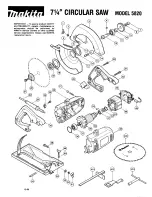
6
EN
5) Battery tool use and care
a)
Recharge only with the charger specified
by the manufacturer
.
A charger that is
suitable for one type of battery pack may
create a risk of fire when used with another
battery pack.
b)
Use power tools only with specifically
designated battery packs.
Use of any other
battery packs may create a risk of injury and
fire.
c)
When battery pack is not in use, keep it
away from other metal objects, like paper
clips, coins, keys, nails, screws or other
small metal objects that can make a
connection from one terminal to another
.
Shorting the battery terminals together may
cause burns or a fire.
d)
Under abusive conditions, liquid may be
ejected from the battery; avoid contact.
If contact accidentally occurs, flush with
water. If liquid contacts eyes, additionally
seek medical help
.
Liquid ejected from the
battery may cause irritation or burns.
e)
Do not use a battery pack or tool that is
damaged or modified.
Damaged or modified
batteries may exhibit unpredictable behaviour
resulting in fire, explosion or risk of injury.
f)
Do not expose a battery pack or tool to
fire or excessive temperature.
Exposure to
fire or temperature above 130 °C may cause
explosion. NOTE The temperature „130 °C“
can be replaced by the temperature „265 °F“.
g)
Follow all charging instructions and do not
charge the battery pack or tool outside
the temperature range specified in the
instructions.
Charging improperly or at
temperatures outside the specified range may
damage the battery and increase the risk of
fire.
6) Service
a)
Have your power tool serviced by a
qualified repair person using only identical
replacement parts.
This will ensure that the
safety of the power tool is maintained.
b)
Never service damaged battery packs.
Service of battery packs should only be
performed by the manufacturer or authorized
service providers.
SAFETY WARNINGS FOR
RECIPROCATING SAWS
• Hold power tool by insulated gripping surfaces,
when performing an operation where the cutting
accessory may contact hidden wiring. Cutting
accessory contacting a “live” wire may make
exposed metal parts of the power tool “live” and
could give the operator an electric shock.
• Keep hands away from the sawing range. Do
not reach under the workpiece. Contact with the
saw blade can lead to injuries.
• Apply the machine to the workpiece only
when switched on. Otherwise there is danger
of kickback when the cutting tool jams in the
workpiece.
• When sawing, the base plate must always faces
against the workpiece. The saw blade can
become wedged and lead to loss of control over
the machine.
• When the cut is completed, switch off the
machine and then pull the saw blade out of the
cut only after it has come to a standstill. In this
manner you can avoid kickback and can place
down the machine securely.
• Use only undamaged saw blades that are in
perfect condition. Bent or dull saw blades can
break, negatively influence the cut, or lead to
kickback.
• Do not brake the saw blade to a stop by
applying side pressure after switching off. The
saw blade can be damaged, break or cause
kickback.
• Use clamps or another practical way to secure
and support the workpiece to a stable platform.
Holding the workpiece by hand or against your
body leaves it unstable and may lead to loss of
control.
• Use appropriate detectors to determine if utility
lines are hidden in the work area or call the local
utility company for assistance. Contact with
electric lines can lead to fire and electric shock.
Damaging a gas line can lead to explosion.
Penetrating a water line causes property
damage.
• When working with the machine, always hold it
firmly with both hands and provide for a secure
stance. The power tool is guided more secure
with both hands.
• Secure the workpiece. A workpiece clamped
with clamping devices or in a vice is held more
secure than by hand.
Summary of Contents for RSM1022
Page 2: ...2 Fig A Fig B Fig C 3 5 8 9 2 1 1 2 6 4 7 ...
Page 3: ...3 Fig F Fig D Fig E 5 4 1 2 ...
Page 24: ...24 ...
Page 25: ...25 Exploded view ...
Page 26: ...26 ...







































